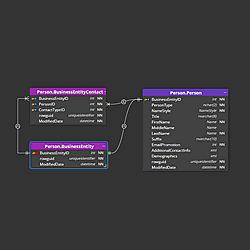Introduction
When designing a database model, creating relationships between tables is essential for organizing data and ensuring data integrity. Relationships are the connections between tables that establish how data in one table is related to data in another table. In this article, we will explore how to create relationships in a database model and why they are important.
Types of Relationships in ER diagrams
There are three main types of relationships in a database model: one-to-one, one-to-many, and many-to-many.
- In a one-to-one relationship, each record in one table is associated with one and only one record in another table.
- In a one-to-many relationship, each record in one table can be associated with one or many records in another table.
- In a many-to-many relationship, each record in one table can be associated with many records in another table, and vice versa.



Creating Relationships in ER diagrams
To create a relationship between two tables, you need to identify the primary key in one table and the foreign key in the other table. The primary key is a unique identifier for each record in a table, while the foreign key is a field in another table that references the primary key. You can create relationships in a database model using SQL commands or using a database tool, incl. database modeling or database design tool.
Benefits of Relationships
Creating relationships in a database model has several benefits.
- First, it helps to eliminate data redundancy and inconsistency by ensuring that each piece of data is only stored once in the database.
- Second, it helps to maintain data integrity by enforcing referential integrity constraints that prevent the creation of orphaned records.
- Third, it allows for efficient querying and retrieval of data by allowing you to retrieve related data from multiple tables with a single query.
Conclusion
In conclusion, creating relationships in a database model is essential for organizing data, maintaining data integrity, and improving data retrieval efficiency. By understanding the types of relationships, how to create them, and the benefits they provide, you can design a robust and efficient database model for your application.
